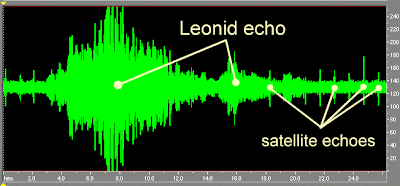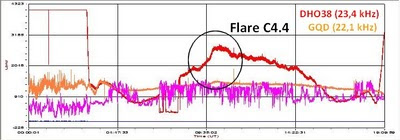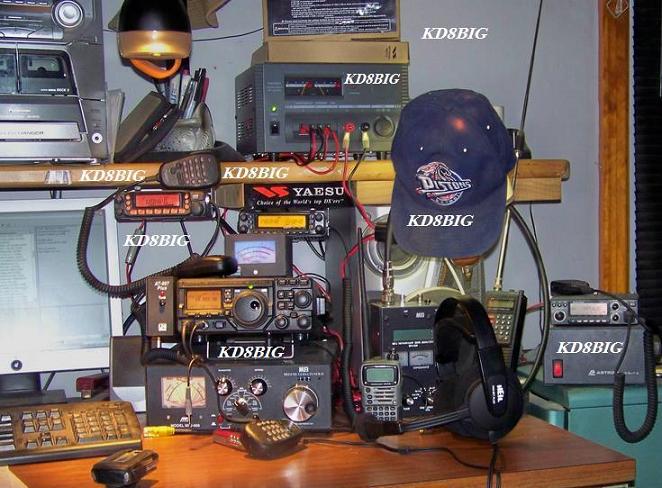Monday, August 30, 2010
TechNet
This is a sample of what I am thinking of in response from of those interested in being a part of the TechNet;
M.A.A.R.C. TechNet.
Topics include the latest news in the worlds manned and unmanned space programs, aeronautics, astronomy events and new discoveries. We will also cover Amateur Astronomy, Model, Mid and High Powered Rocketry, as well as Amateur Radio activities related to space such as monitoring meteor activity, contacting the International Space Station, using Amateur Radio Satellites, EME (Moonbounce) and how to use Orbital Plotting software.
Outside of Space topics we will also discuss;
How to use your radio, Radio Orienteering,Building mini transmitters for ROCA, Antenna Construction,Sound Card-to-Rig Interfaces, Cables and Connectors, DSP Manufacturers, Interfaces Manufacturers, Radio Manufacturers, Packet Radio, PSK31, Radio Programming Cables, RTTY, Ham Radio Software, Networking issues, Operating System issues and many other High Tech Radio-Computer related issues. This is just a few suggestions.
Saturday, August 28, 2010
Tower Climb to 1768 Feet
Friday, August 27, 2010
Earth's atmosphere/ Shrinking
The sun's energy output dropped to unusually low levels from 2007 to 2009, a significantly long spell with virtually no sunspots or solar storms, according to scientists from the National Centre for Atmospheric Research in Boulder, Colorado.
During that period, the thermosphere, whose altitude ranges from about 90-500km, shrank and contracted from the sharp drop in ultraviolet radiation, said the study published in the American Geophysical Union's journal Geophysical Research Letters.
A narrower, less dense thermosphere is good news for satellites orbiting Earth, including the International Space Station, since reduced friction means they can remain aloft longer, said University of Colorado professor and study co-author Thomas Woods.
source
Thursday, August 26, 2010
Tmate (what your SDR always wanted)
 This is really cool, A friend sent this to me. We talked about this while on Echo-Link. Seems like the really cool stuff is going on in Europe.
This is really cool, A friend sent this to me. We talked about this while on Echo-Link. Seems like the really cool stuff is going on in Europe. Tmate is the most awaited accessory by many users of SDR radio that can not or will not stay without the VFO knob! With a classical tuning knob, the USB interface and the upgradable software, allows the control of main functions of the various SDR software. Intended mainly to allow the use of SDR software without the need to watch the screen of the PC, or when the screen of the PC is crowded by various programs such as LOG or software for DIGITAL operations or CONTEST.
Wednesday, August 25, 2010
Meteor Explosion
“Everything shook. I’ve never been in an earthquake, but it was that kind of a thing.”
Two reports had been registered on the Sydney Observatory ‘Lights in the Sky’ blog page that most likely related to the occurrence. The reports tell of sightings of a daytime meteor between 1.50pm and 2pm on the Tuesday. “A meteor bright enough to be seen during the day may well be sufficiently large to survive the journey through the atmosphere and become a meteorite on the ground. However, unless it was seen to land we are unlikely to ever find out.”
Saturday, August 21, 2010
Friday, August 20, 2010
Isotron Antennas
 So here I am looking at different antennas. Anyone of my readers have any experience with the Isotron Antenna?
So here I am looking at different antennas. Anyone of my readers have any experience with the Isotron Antenna?I'm looking to purchase the 75/80.
I did hear from a local ham that they are a good antenna.
I also heard from another local ham that they are not worth a dime.
Isotron Antenna Home Page
Thursday, August 19, 2010
Working Amateur Radio Satellites
It is not rocket science to be able to listen to the birds in outer space nor is it to transmit.
It dose however require some time, practice and research.
I always suggest obtaining some type of orbital plotting software; once you get it take some time to understand it.
Ounce you have achieved that then pick out a Satellite and listen to it for a few days. After you have done that then try and make your first contact. It may take you a day or a few weeks. The thing is never give up.
Equipment, that can be pricey it you want it to be. I have always been one for buying the best. I know not everyone is able to that. Heck, I fall into that boat currently.
My suggestion for equipment is a good duel band HT. I have a VX-7R; I’m hoping to get the new VX-8R soon.
Next, the Antenna, you can make one if you wish but I suggest you save the time and hassle and purchase on. Arrow makes a nice 3 element VHF, 7 element UHF with a 10 watt duplexer.
Here are a couple of videos and I hope these help those of you with questions.
How to work amateur radio satellites with your handheld (HT) radio from moleculo on Vimeo.
Wednesday, August 18, 2010
METEOR ECHOES
 The Air Force Space Surveillance Radar is scanning the skies above Texas. When a meteor or satellite passes over the facility--ping!--there is an echo. Click on the button to listen to a live audio feed.
The Air Force Space Surveillance Radar is scanning the skies above Texas. When a meteor or satellite passes over the facility--ping!--there is an echo. Click on the button to listen to a live audio feed.http://topaz.streamguys.tv/~spaceweather/
CME Missed Us.
The CME expected to hit Earth's magnetic field on Aug. 17th either missed or delivered such a feeble blow that no one noticed the resulting geomagnetic disturbance. The next opportunity for auroras is Aug. 24th when an incoming solar wind stream could provoke polar geomagnetic storms.
I also saw this on SpaceWeather.com
Tuesday, August 17, 2010
MFJ-1796
I have now owned this antenna for almost a year. What do I think about it?
It is awesome~
I bought this antenna from a local ham who was moving out of state and had no desire to take it with him. Best 65.00 dollars I ever spent.
I have made contacts to Central and South America, Virgin Islands, Azores, U.K., Spain, France and Germany. I have even made the trip to Alaska. What a great antenna the MFJ 1796 has been for me.
I have also contacted a majority of the lower 48. I would have to go through my log book but I am confident I have more than 50% of them logged. I guess not bad for a 10 month General.
The MFJ 1796 is a six band halfwave vertical antenna. Since it's a ground independent halfwave, no radials or ground plane are needed.
The antenna is very efficient because it is end loaded, sothe entire antenna radiates power. It uses no lossy traps, and achieves close 50 Ohm match on all bands, with no band switching. Easy to build and easy to tune!
band coverage; 40, 20, 15, 10, 6, 2m
height; 33 feet
power rating;1500 Watts, PEP
weight; 15 pounds
So lets get to the bottom line on this antenna – its a balanced dipole with loading coils (not traps) and capacity hats at each end. The length of the antenna is 12 feet as delivered from MFJ. Its as simple as that.
The MFJ-1796 as delivered by MFJ is expected to be used as a vertical and mounted on the ground, on a tripod on a roof, or attached to a chimney. Its a center-fed vertical dipole that is ground independent – that is, it does not require a counterpoise or grounding system.
Monday, August 16, 2010
IONOSPHERIC DISTURBANCE

"SID" stands for Sudden Ionospheric Disturbance, and a "SID monitor" is a radio receiver that monitors ~20 kHz signals from distant transmitters. "My system easily detected the effects of the solar flare," says Karlovsky. "I monitor two stations: DHO38 in Germany (23.4 kHz) and GQD in Great Britian (22.1 kHz). The German signal was most strongly boosted."
With solar activity on the rise, sudden ionospheric disturbances will become more common. Interested? Stanford University tells you how to build your own SID monitor.
source
Sunday, August 15, 2010
CME/ Glancing Blow to Earth's Magnetic Field Aug. 17.

The sun has produced three bright coronal mass ejections (CMEs) this weekend. None is heading directly for Earth, although the CME of Aug. 14th might deliver a glancing blow to Earth's magnetic field on August 17th.
SOHO captured this video clip of a full halo coronal mass ejection (CME) that blasted a substantial cloud of particles away from the Sun (Aug, 7, 2010). The majority of the cloud went to the left with only a smaller portion heading to the right, suggesting that it would not likely have any strong impact on Earth. A “halo” cloud is one that appears to surround the Sun on all sides as it expands, meaning it is heading somewhat towards Earth or away from it. The still and movie are generated by processing the changes from one frame to the next to highlight those changes, thus, we call this a “difference movie.” Click Here
Saturday, August 14, 2010
SUNSPOTS ERUPT IN TANDEM
The explosion lasted for more than two hours, giving many amateur astronomers time to catch the eruption in action. Other than photo-ops, however, this explosion will probably not affect Earth much. The cloud ejected by the blast is not heading our way.
Wednesday, August 11, 2010
KD8BIG Update
I did however make it to the local amateur radio club meeting and talked to those present about my idea of having a tech net.
How about the activity on the Sun? Wow, very kewl~
I thought I would share this link, it has some really awesome pictures of the Auroras this week due to the activity going on the Sun.
Huge Solar Storm Triggers Unusual Auroras
Tuesday, August 3, 2010
Cosmic Tsunami on the way

A dream come true for the Amateur Radio Operator.
Tonight the bands are really active. I have made contacts on 2, 6, 10, 15, 20 and 40 meters. I tried to make a contact on 80 and 160, no joy.
Solar Tsunami to Strike Earth
HOW TO READ PROPAGATION NUMBERS
The A index [ LOW is GOOD ]
- 1 to 6 is BEST
- 7 to 9 is OK
- 11 or more is BAD
Represents the overall geomagnetic condition of the ionosphere ("Ap" if averaged from the Kp-Index) (an average of the eight 3-hour K-Indices) ('A' referring to amplitude) over a given 24 hour period, ranging (linearly) typically from 1-100 but theoretically up to 400.
A lower A-Index generally suggests better propagation on the 10, 12, 15, 17, & 20 Meter Bands; a low & steady Ap-Index generally suggest good propagation on the 30, 40, 60, 80, & 160 Meter Bands.
SFI index [ HIGH is GOOD ]
- 70 NOT GOOD
- 80 GOOD
- 90 BETTER
- 100+ BEST
The measure of total radio emissions from the sun at 10.7cm (2800 MHz), on a scale of 60 (no sunspots) to 300, generally corresponding to the sunspot level, but being too low in energy to cause ionization, not related to the ionization level of the Ionosphere.
Higher Solar Flux generally suggests better propagation on the 10, 12, 15, 17, & 20 Meter Bands; Solar Flux rarely affects the 30, 40, 60, 80, & 160 Meter Bands.
K index [ LOW is GOOD ]
- 0 or 1 is BEST
- 2 is OK
- 3 or more is BAD
- 5 is VERY VERY BAD
The overall geomagnetic condition of the ionosphere ("Kp" if averaged over the planet) over the past 3 hours, measured by 13 magnetometers between 46 & 63 degrees of latitude, and ranging quasi-logarithmically from 0-9. Designed to detect solar particle radiation by its magnetic effect. A higher K-index generally means worse HF conditions.
A lower K-Index generally suggests better propagation on the 10, 12, 15, 17, & 20 Meter Bands; a low & steady Kp-Index generally suggest good propagation on the 30, 40, 60, 80, & 160 Meter Bands.
Terms of Service
I am not responsible for any thing that happens to your mental health, computer and all personal property because you visited my site.
This site is a collection of some things sent to me by e-mail, obtained from other blogs and the internet. If there is a picture or quote that is copyrighted to you let me know and I will remove your item .
Thoughts expressed in my blog are just that . I give My Opinion on the many events, products and how too, reported by the media and other web-sites.
Do not use this blog site to obtain weather events or disasters information. What I post may not be correct. Always get information from the proper media, weather (NWS)(NOAA)
Pacific Tsunami Warning Center and USGS sites










